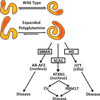Polyglutamine neurodegeneration: expanded glutamines enhance native functions
- PMID: 22284692
- PMCID: PMC3340441
- DOI: 10.1016/j.gde.2012.01.001
Polyglutamine neurodegeneration: expanded glutamines enhance native functions
Abstract
An intriguing set of neurodegenerative disease are the nine disorders caused by the expansion of a unstable trinucleotide CAG repeat where the repeat is located within the coding of the affected gene, that is, the polyglutamine (polyQ) diseases. A gain-of-function mechanism for toxicity in polyQ diseases is widely thought to have a major role in pathogenesis. Yet, the specific nature of this gain-of-function is a matter of considerable discussion. The basic issue concerns whether toxicity stems from the native or normal function of the affected protein versus a novel function induced by polyQ expansion. For at least three of the polyQ disease considerable evidence is accumulating that pathology is mediated by a polyQ-induced exaggeration of a native function of the host protein.
Copyright © 2012 Elsevier Ltd. All rights reserved.
Figures


References
-
- La Spada AR, Wilson EM, Lubahn DB, Harding AE, Fischbeck KH. Androgen receptor gene mutations in X-linked spinal and bulbar muscular atrophy. Nature. 1991;352:77–79. - PubMed
-
- Orr HT, Zoghbi HY. Trinucleotide Repeat Disorders. Ann Rev Neurosci. 2007;30:575–621. - PubMed
-
- Gatxhel JR, Zoghbi HY. Diseases of unstable repeat expansion: Mechanisms and common principles. Nat Rev Genet. 2005;6:743–755. - PubMed
-
- Kennedy WR, Alter M, Sung JH. Progressive proximal spinal and bulbar muscular atrophy of late onset. A sex-linked recessive trait. Neurology. 1968;18:671–680. - PubMed
-
- Schmidt BJ, Greenber CR, Allingham-Hawkins DJ, Spriggs EL. Expression of X-linked bulbospinal muscular atrophy (Kennedy disease) in two homozygous women. Neurology. 2002;59:770–772. - PubMed
Publication types
MeSH terms
Substances
Grants and funding
LinkOut - more resources
Full Text Sources
Medical

